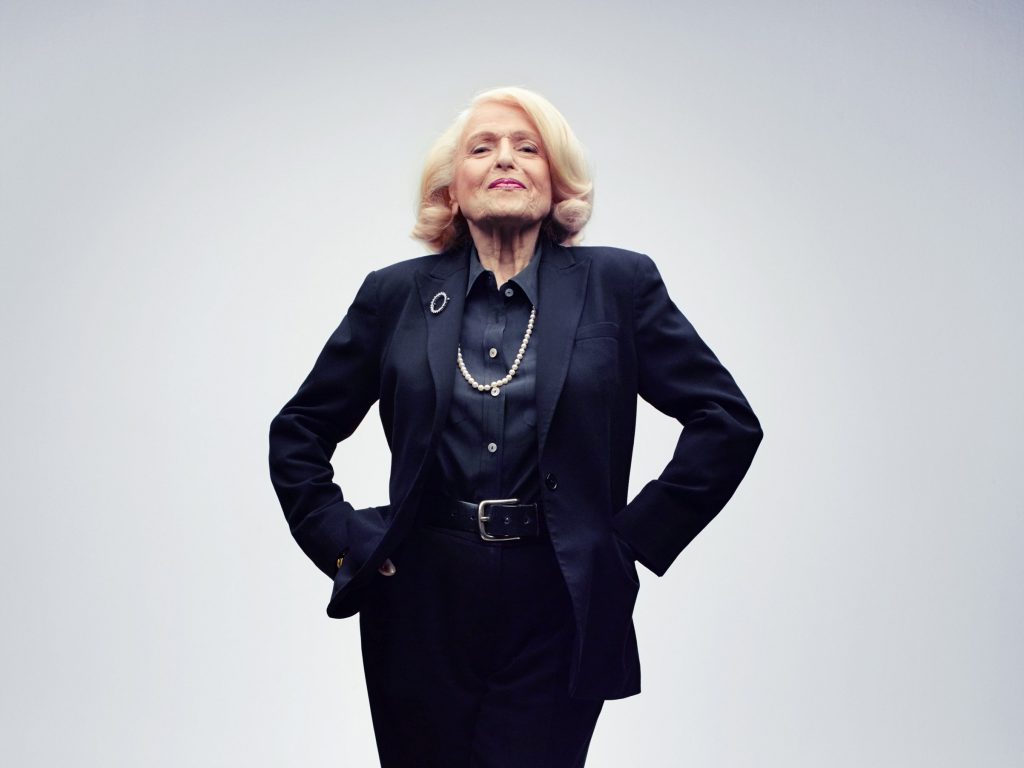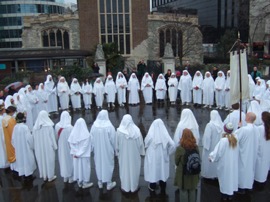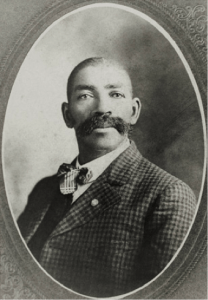Winner of the Spring 2019 StMU History Media Award for
Best Article in the Category of “Gender Studies”
According to Roberta Kaplan, her attorney, Edie (Edith) Windsor surely didn’t know what was ahead of her. As a young, middle-class woman growing up in Philadelphia after the Depression and World War II, she obviously had no idea what her future would hold. When asked shortly after her case was filed what it felt like to be a plaintiff, Windsor remarked that it’s one thing to be “out” as a lesbian, but it’s another thing entirely to be the “out lesbian who just happens to be suing the United States of America.”1
Edie Windsor was called in by the FBI for an interview when she was working for the Atomic Energy Commission in the 1950s. She rightfully feared that if the FBI were to ask her if she were a lesbian she would not only lose her job, but her career. For most of her career as a computer programmer, it was a felony to have any employment with the federal government if you were gay. The New York Times published a Civil Service memo from the Johnson administration stating that in evaluating cases of homosexuality, officials automatically declared the individual not suitable for federal employment. This was all of a piece with Windsor’s life between the fifties and the present, though times did begin to change in the 1960s: Thea Spyer, Windsor’s late spouse, first proposed in 1967, two years before the “Stonewall Riots” that led to the modern gay rights movement. Spyer proposed with a diamond brooch instead of a diamond ring because she was afraid of “outing” Windsor at her job. It was also illegal in 1967 to be a lesbian and to be working for a company like IBM that had contracts with the federal government.2
The facts speak for themselves: Windsor lived through a difficult time to be gay or lesbian in the United States, a time which simply being gay or lesbian was a criminal offense. These facts will later influence the judges’ decision-making process in her cases and point towards the direction they must take in their findings. For example, it’s hard to conclude gay and lesbian people have not suffered discrimination when you could legally lose your job or be jailed simply for being gay or lesbian.
Dr. Thea Spyer, a clinical psychologist, died in 2009, leaving a substantial estate to her spouse, Ms. Edith Windsor. Spyer and Windsor had been partners for nearly thirty-five years at the time of Spyer‘s death, and New York law recognized them as legally married. Had Windsor been married to a man, the money would have been exempt from federal estate taxes under the Internal Revenue Service Code’s “spousal exemption.” However, section 3 of DOMA (the Defense of Marriage Act, passed in 1996 by Congress) provided that the term “spouse” for federal law purposes excluded members of same sex couples. Section 3 defines “spouse” to mean only “a person of the opposite sex who is a husband or a wife.” Windsor was required to pay over $363,000 in federal estate tax. Any American, Democrat or Republican, straight or gay, can understand what it means to have to pay a huge tax bill simply because you are gay. She paid the tax and sued the United States (specifically, the Internal Revenue Service) for a refund on the ground that DOMA’s definition of spouse was unconstitutional.3
In order to discuss the trials, it will help to understand the Equal Protection Clause of the 14th Amendment, the basis upon which most of the decisions were made. It states:
Amendment XIV, Section 1:
All persons born or naturalized in the United States, and subject to the jurisdiction thereof, are citizens of the United States and of the state wherein they reside. No state shall make or enforce any law which shall abridge the privileges or immunities of citizens of the United States; nor shall any state deprive any person of life, liberty, or property, without due process of law; nor deny to any person within its jurisdiction the equal protection of the laws.4
Equal protection, in United States law, is the constitutional guarantee that no person or group will be denied protection under the law that is enjoyed by other persons or groups: in other words, persons similarly situated must be similarly treated. Equal protection is extended when the rules of law are applied equally in all similar cases and when persons are exempt from obligations greater than those imposed upon others in like circumstances. The Fourteenth Amendment to the U.S. Constitution, one of three amendments adopted in the immediate aftermath of the American Civil War (1861–65), prohibits states from denying to any person “the equal protection of the laws.”5
Edie Windsor asked several civil rights groups specializing in gay rights to take her tax suit and was turned down by all of them (including GLAAD, HRC, and Lambda Legal). She then spoke to an activist friend of hers who knew a legal “headhunter.” He put her in touch with Roberta Kaplan who, ironically, had been a patient of Spyer’s. Ms. Kaplan knew she would take the case; she was already an established lawyer with one of New York City’s major law firms, and it was no longer controversial for a lawyer at a large firm to take a gay case (five states had already legalized same-gender marriage, including two neighboring states.6
Shortly after Windsor was filed, gay rights organizations wanted a moratorium on new cases. Around the same time as Kaplan filed suit, David Boies and Theodore Olson had filed a federal lawsuit in California challenging Proposition 8 (the ballot-based amendment to the state constitution overturning the right of same-gender marriage in the state). They were the opposing lawyers in Bush v. Gore, the case that decided the 2000 presidential election, and hence very familiar to the Supreme Court. The case challenging Proposition 8 would go on to become Hollingsworth v. Perry. It and Windsor became the precedents for Obergefell v. Hodges.7
The first stop for the case was the Southern District Court for the State of New York. In late January 2011, Roberta Kaplan received a phone call from the Department of Justice asking for a delay. The DOJ was required to defend the IRS. Kaplan refused the extension. On January 21, she received a phone call from Associate Attorney General Anthony West, the number three man in the Justice Department. Mr. West said he was calling again because Attorney General Eric Holder and President Barack Obama needed time to decide the government’s position on the case. Another complication was that the Second Court of Appeals had yet to analyze how it treated discrimination cases against gay people. Windsor might be setting a precedent.8

During her spring break from Columbia University, Roberta Kaplan received an email from a staffer at the Department of Justice asking about her availability for a conference call with Anthony West and leaders of the gay civil rights movement. Because of the list of names of attendees, it appeared possible the Obama administration had decided to not defend DOMA. In the call, West told them that he, Attorney General Holder, and President Obama discussed the matter at great length and decided that the law was unconstitutional, that they would not defend the law, and that they would recommend the court look at it under heightened scrutiny (heightened scrutiny sets a higher standard for a federal law to withstand a challenge).9
Republican House Speaker John Boehner swiftly declared his intention to convene the Bipartisan Legal Advisory Group (BLAG) of the U.S. House of Representatives to consider how the House should proceed. The BLAG is composed of five members of the House leadership: the speaker, the majority and minority Leaders, and the majority and minority whips. The BLAG voted along party lines (the Republicans in favor of intervening in Windsor, the Democrats against). Boehner announced that the BLAG itself would defend DOMA in court; it appeared the Republicans in Congress had decided to politicize the case. The BLAG hired Paul Clement, a former Solicitor General (the chief trial attorney in the Justice Department, responsible for arguing cases before the U.S. Supreme Court, and sometimes also known as the President’s personal lawyer) and promptly filed briefs in several pending cases, seeking permission for the BLAG to intervene “for the limited purpose of defending the constitutionality of Section III” of DOMA.10 The cases included Windsor and Hollingsworth, and intervening would prove a costly error for the Republicans.
In February 2012, the Ninth Circuit Court of Appeals ruled on Proposition 8, saying it was unconstitutional and setting up an automatic appeal to the U.S. Supreme Court. Weeks later Washington and Maryland became the seventh and eighth states to legalize same gender marriage, and in one of the four DOMA challenges working its way across the country, a California district court judge had ruled DOMA unconstitutional. It was clear that due to political pressure, one of four DOMA cases was going all the way to the Supreme Court. The pressure was now on Roberta Kaplan to get a ruling from the district court if she wanted to keep Windsor in the mix.11 Then, to Kaplan’s surprise, on June 6, 2012, Judge Jones of the district court ruled that DOMA was unconstitutional, even under rational basis scrutiny (the weakest of the three types of review a law can undergo). Immediately following this, Republicans in Congress pressured BLAG to appeal.
On September 27, 2012, the case went before Chief Justice Jacobs of the Second Circuit Court of Appeals. What interested Kaplan most was that Judge Jacobs seemed interested in whether the case should be reviewed under heightened scrutiny rather than rational basis. The chances of DOMA surviving heightened scrutiny in front of a Circuit Court of Appeals were slim. Roberta Kaplan knew that Justice Jacobs intensely disliked any groups using public interest litigation to promote their own agendas, social or political. Kaplan thus kept her argument to the facts and basis of the case. She noted that Judge Jones of the district court had found section 3 of DOMA unconstitutional. Kaplan argued that the case was about an unfair tax burden, not about the federal right to marry.12
On October 12, the Second Circuit ruled. Justice Jacobs, in a scathing opinion, declared that DOMA deserved consideration under heightened scrutiny. He found it prejudicial against a class of citizens and highly discriminatory. Windsor now had a circuit court opinion recommending heightened scrutiny, which now made it the favorite to be the case heard by the Supreme Court, since Justice Kagan would have needed to recuse herself from the other likely case (Elena Kagan had been Solicitor General when the other favored case was in the lower federal courts).13

By March of 2013, Windsor had already gotten cert (the right to be heard) before the Supreme Court and Kaplan felt that she needed to add another knockout blow to her case. She also wanted to help repair the damage done to the image of someone who generally had a good reputation with the American people, including LGBTQ persons: she asked Bill Clinton to write an editorial saying he regretted signing DOMA. On March 7, President Clinton wrote an op-ed for The Washington Post entitled “It’s Time to Overturn DOMA.” This was additional damage to those wanting to defend DOMA. Not only was the President who had signed it against it, but so were a good deal of the legislators who created it and passed it.14
March 27, 2013 saw the start of oral arguments in U.S. v. Windsor. The court had just heard Hollingsworth v. Perry the day before, having decided to hear the DOMA cases on successive days. Paul Clement for BLAG spoke first. He told the justices that the federal government has the “choice to adopt a constitutionally permissible definition” of marriage rather than have to submit to the pro-LGBTQ equality choices of states like New York. This angered Justice Ginsberg, who stopped him and asked what kind of marriage it would be if states were allowed to define marriage but not give the same benefits to opposite- and same-gender couples. Justice Kennedy then questioned the 1,100 laws which DOMA seeks to regulate and that interfere with states’ rights to regulate marriage. Clement still continued to claim that DOMA did not interfere with marriage. A few minutes later the BLAG and its counsel made one of the mistakes that would define the case. Clement was still arguing that DOMA does not interfere in benefits. Justice Ginsberg stepped in and contrasted what was given to opposite-gender couples versus same-gender couples. She coined the phrase “skim milk marriage,” much to the embarrassment of Clement. Ginsberg then invoked the name of Justice Kennedy, the swing vote in most decisions decided along ideological lines. Justice Kagan then interpolated that maybe Congress was not seeking uniformity, but segregation of a class of people, with animus.15
Clement tried to move on but Justice Kagan was not through with him. Justice Kagan quoted The Congressional Report from 1996, saying that Congress decided to express “moral disapproval” of homosexuality. Clement was on shaky ground and was forced to say, “And if that’s enough to invalidate the statute, then you should invalidate the statute.” Once Clement admitted that, the BLAG had essentially lost the case.16
After that exchange, the focus of the discussion turned to states’ rights to regulate marriage, the so-called federalism issue. The conservative justices tried to get both Solicitor General Verrilli and Roberta Kaplan to concede the issue. Luckily, Roberta Kaplan kept the focus on the equal protection clause. By keeping the issue of federalism out, she eliminated the potential for states to later deny benefits to legally married same-gender couples.17
In getting past federalism, Roberta Kaplan irked some in the LGBTQ rights community. But as she said, “My job was to win Edie’s case, which was about one woman and one estate tax bill, not to make broader arguments about positions the Obama administration should take with respect to states like North Carolina that did not have marriage equality.”18

On June 26, 2013, the Supreme Court had to make its final decisions for the term, including ruling on Hollingsworth and Windsor. As it turned out, in United States v. Windsor, the Supreme Court ruled 5-4 to strike down DOMA. In Hollingsworth v. Perry, the court voted 5-4 to not rule on merit, saying the defenders of Proposition 8 lacked standing to sue, upholding the district court decision that same-gender marriages could resume in California.19
Epilogue
In Congress, the majority party’s use of BLAG to intervene in a tax case because one of the parties was lesbian came back to haunt them.
In the next two years, more than two dozen states struck down laws prohibiting same-gender marriage following the Windsor decision. Ironically, DOMA had been what was upholding the laws. If BLAG had let Edie Windsor win in district court, there would have likely been no Circuit Court or Supreme Court decision declaring DOMA unconstitutional.
As stated in the decision on Obergefell v. Hodges (the case that legalized same-gender marriage nationwide on June 26, 2015):
“In 2012, the federal Defense of Marriage Act was also struck down… in United States v. Windsor… Numerous same-sex marriage cases reaching the federal courts and state supreme courts have added to the dialogue… The Fourteenth Amendment requires a State to license a marriage between two people of the same sex… The fundamental liberties protected by the Fourteenth Amendment’s Due Process Clause extend to certain personal choices central to individual dignity and autonomy, including intimate choices defining personal identity and beliefs… Courts must exercise reasoned judgment in identifying interests of the person so fundamental that the State must accord them its respect.20
Justice Kennedy in his opinion on the case touched on the importance of recognizing the stigma, discrimination, and violence LGBTQ people endure in U.S. society and how marriage can help mitigate these. In his decision, he quoted a passage from the Massachusetts case that led to the legalization of same-sex marriage in that state (Goodridge v Dept of Public Health 2003). Marriage has an essential role in this nation as “it fulfills yearnings for security, safe haven, and connection that express our common humanity; civil marriage is an esteemed institution, and the decision whether and who to marry is among life’s momentous acts of self-definition.”21
Most people cannot perceive how one judicial case can affect another: in Obergefell, the Supreme Court cited Loving v. Virginia (the landmark 1960s case that struck down laws against interracial marriage). It is not that much of a stretch from Loving to Windsor to the next generation of civil rights.
- Roberta Kaplan,” It’s All About Edie Stupid,” Keynote Address at Columbia Law School’s May 22, 2014, graduation ceremony. ↵
- Roberta Kaplan,” It’s All About Edie Stupid,” Keynote Address at Columbia Law School’s May 22, 2014, graduation ceremony. ↵
- Roberta Kaplan,” It’s All About Edie Stupid,” Keynote Address at Columbia Law School’s May 22, 2014, graduation ceremony; ACLU, “Windsor v. United States.” ↵
- U.S. Constitution, Amendment XIV, section 1. ↵
- Encyclopedia Britannica, s.v. “Equal Protection,” accessed March 12, 2019, ttps://www.britannica.com/topic/equal-protection. ↵
- Roberta Kaplan and Lisa Dickey, Then Comes Marriage (New York: W.W. Norton & Company, 2015), 112-115. ↵
- Roberta Kaplan and Lisa Dickey, Then Comes Marriage (New York: W.W. Norton & Company, 2015), 117-118. ↵
- Roberta Kaplan and Lisa Dickey, Then Comes Marriage (New York: W.W. Norton & Company, 2015), 138-140. ↵
- Roberta Kaplan and Lisa Dickey, Then Comes Marriage (New York: W.W. Norton & Company, 2015), 144-145. ↵
- Matthew I. Hall, “How Congress Could Defend DOMA in Court (and Why the BLAG Cannot),” Stanford Law Review (website) (January 2013). ↵
- Roberta Kaplan and Lisa Dickey, Then Comes Marriage (New York: W.W. Norton & Company, 2015), 178-179. ↵
- Roberta Kaplan and Lisa Dickey, Then Comes Marriage (New York: W.W. Norton & Company, 2015), 192-194. ↵
- Roberta Kaplan and Lisa Dickey, Then Comes Marriage (New York: W.W. Norton & Company, 2015), 194-197. ↵
- Roberta Kaplan and Lisa Dickey, Then Comes Marriage (New York: W.W. Norton & Company, 2015), 232-233. ↵
- Roberta Kaplan and Lisa Dickey, Then Comes Marriage (New York: W.W. Norton & Company, 2015), 263-267. ↵
- Roberta Kaplan and Lisa Dickey, Then Comes Marriage (New York: W.W. Norton & Company, 2015), 268-269. ↵
- Roberta Kaplan and Lisa Dickey, Then Comes Marriage (New York: W.W. Norton & Company,2015), 272-276. ↵
- Roberta Kaplan and Lisa Dickey, Then Comes Marriage (New York: W.W. Norton & Company,2015), 277. ↵
- Roberta Kaplan and Lisa Dickey, Then Comes Marriage (New York: W.W. Norton & Company, 2015), 292. ↵
- Obergefell v. Hodges, 14-556 U.S. (2014). ↵
- Kristina B . Wolff,” ‘I Do, I Don’t,” Humanities no. 6, 12 (2017); 2. ↵




37 comments
Sarah Uhlig
This woman is so inspiring in how she fought for the discrimination of these people in the workforce, not only for them but for herself. I like reading historical articles about how people fought against discrimination and fought for equality among all kinds of people. This woman took her situation and other examples of discrimination and continued to lead a path for equality and freedom of love for everyone.
Paola Arellano
The story of Windsor is really inspiring. It kind of reminded me of another article that mentioned the family that made it possible to marry interracially. Change has been made in the United States and it continues to be made. The laws change depending on the time. And this is just an example of how society has evolved. I think that it took a lot of courage for her to bring this up to the supreme court, even after her partner’s death. I think that the decision made was the right one and it makes me happy to know that we are making steps towards a brighter future.
Mariah Cavanaugh
The cover image you chose is powerful and says so much about Edie Windsor. I am ashamed to say I was not at all familiar with this case so being able to read your article was wonderful! In your article you touched on the fact that GLAAD, HRC and Lambda Legal refused to take her case. You didn’t mention why they turned her down though. It was interesting to me that those three groups are such an integral part of the LGBTQ movement yet turned down the opportunity to take on a landmark case. Great job!
Christopher Hohman
Nice article. I have never heard of the Edith Windsor or her story before. I must admit that I found the title a bit confusing at first because The Duchess of Windsor was the title for the former King Edward VIII’s wife after they married in 1937. It is quite sad that there were those who wished to infringe upon Edith’s rights especially as it relates to her spouse. I am glad that we now live in a country where gay people are allowed to marry each other.
Maya Mani
I have so much respect Edie Windsor! After reading this article I know so much about her. The structure and writing of this article is great, making this a great narrative. As for the story, I think it’s incredible how she was able to make this change, and although it’s a controversial topic, I think it can be impactful for anyone who reads this article.
Joshua Garza
Great article! I loved the subject and the detailed timeline of how everything worked out. I love this article for what the lady stands for, how she impacted the progression of real freedom in my modern day lifetime and especially the pictures used in this article to better illustrate who the Duchess is and how good of a person she is.
Rosario Moreno
I honestly loved the images you used, they were so clear and symbolized well. It is crazy how certain things could have such a huge effect on other things. How this one case basically laid the foundation to gay marriages now. It was unfair how the LGBTQ community was treated at that time and even now, great article, very descriptive.
Thomas Fraire
This article’s title drew me in, it was a bazaar and caught my eye and I was interested to see what it was about. Congregations on your nomination though, you. can really see that what you researched was something you were passionate about. It is a shame she women don’t get more recognition for the things that they do. It is incredible to see how far our country has come in terms of the LBGTQ movement has helped our country progress
Nadia Carrasco
Clicking on this article it was the title that got my attention. I originally thought that they were going to talk about their personal reasons on why gay marriage should be legal. Although I was partly wrong, this article was still very interesting to read. I never realized how much one court case could really change and decide something for a big population. The research in this article was done well and written very easy to comprehend. Great Job !
Mia Morales
I always enjoy reading about women who help change history. I appreciate this article because I feel like more people should know about Kaplan and how this case helped change the lives for many LGBTQ couples. This was a well written article and I enjoyed reading it!